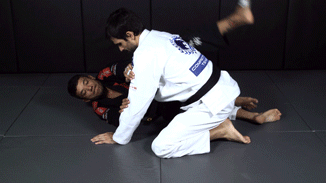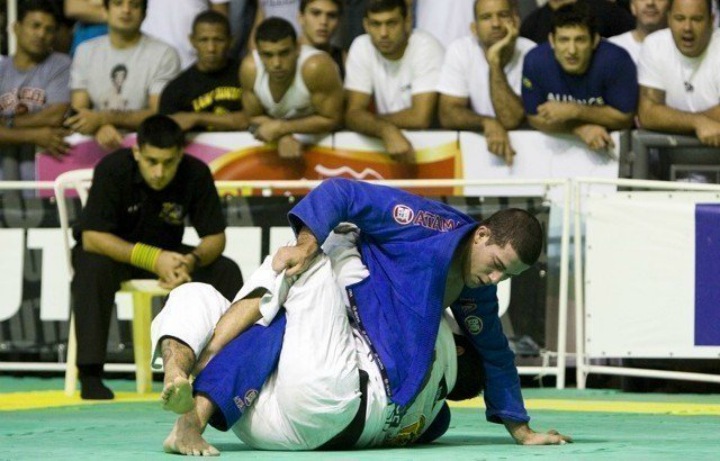Guest post by Evolve MMA, Asia’s premier championship brand for martial arts. It has the most number of World Champions on the planet. Named as the #1 ranked martial arts organization in Asia by CNN, Yahoo! Sports, FOX Sports, Evolve MMA is the best Singapore BJJ gym.
There’s no doubt that the half guard is one of the most versatile positions in BJJ. Developed in the 1990’s by Roberto “Gordo” Correa, legend has it that Gordo developed the move as a means to prevent his sparring partners from passing his guard while rehabilitating a leg injury. He would often find himself stuck in this position, so finding ways to attack from the half guard was necessary.
Although there are many versions of the half guard, the two most commonly used positions are the deep half guard and the classic half guard. The classic half guard pays tribute to Gordo’s use of the underhook to take the back, a move that he has used against many formidable opponents in competition. Today, many of the top BJJ competitors such as Lucas Leite, Caio Terra, Ryan Hall, Bernardo Faria, and Leonardo Nogueira are all masters of the half guard.
If you’ve wanted to take your half guard game to the next level or learn the basics, you’re in luck! Today, Evolve Daily shares 5 Essential Rules For A Killer Half Guard:
1) You must never let your back touch the floor

This is the cardinal rule of playing half guard. The minute your back is flat on the floor, you can be certain that your guard will probably be passed. You should, at all times, fight to stay on your side. Not only will this prevent your opponent from passing your guard easily, it will also be easier for you to attack from this position.
Notice how BJJ World Champion and ONE Superstar Alex Silva stays on his side to set up the underhook. He uses the double paw grip to frame and create space, making it easier to get the underhook and finish the single leg.
2) You must never let your opponent control your head

Ask any BJJ student how to pass the half guard and they’ll tell you that the first move they’ll try to establish is the cross face. Once your opponent has head and arm control, it will be difficult for you to attack from the half guard because having this control allows them to flatten you and keep your shoulders on the mat.
The frame that Alex uses above prevents his opponent from establishing head and arm control. As soon as he gets the underhook, he moves his head up and out and bases with his free hand. From here, he grabs his opponent’s belt and finishes the sweep.
3) You must keep on moving

Half guard is always a game of inches. You must keep on moving and make your opponent react in small ways so that they can never take advantage of the position. Whether you push, pull, hook their ankle with your foot or bump them with your knee, you must keep on doing something to prevent yourself from getting squashed.
In the technique above, Alex’s opponent has attempted to pass the guard by stepping to to the side. Alex sets up the sweep by loosening the collar and creating a grip. He switches his feet into a gancha then finishes the sweep. Notice how Alex is constantly moving, refusing to give up the pass.
4) You must use a frame
Using frames and maintaining them are essential in BJJ, especially in the half guard position. Using a stiff arm or an elbow to keep your opponent’s weight off you or the knee shield, you create space to work your attacks. The more space you have, the more options you have for offense.
All throughout the video above, you’ll notice that whenever Alex gets into the half guard, he uses frames to create space to work his attacks. Using a frame makes it easier for Alex to get on his knees and get the underhook or have the option to transition to another guard.
5) You must know at least 2 variations of the half guard
To develop a solid half guard game, you must know at least 2 variations of the half guard. One of these variations should be the classic underhook half guard. For the other variations, you can choose among: deep half, knee shield (93 or Z guard, half butterfly, seated half, lockdown and more. Knowing the classic half guard gives you the foundation you need to approach the other guards mentioned. It is also a great way to transition to other guards, which, as you know, is a must in BJJ.
In the video above, Alex demonstrates the waiter sweep from the deep half guard. The main difference between the deep half guard and the classic half guard is that the deep half guard requires you to pull your opponent on top of you completely.

To successfully incorporate the half guard into your BJJ game, you must remember the pointers above. And the easiest way to do so is through constant drilling and application in sparring. So tell us, when will you start using the half guard?

















